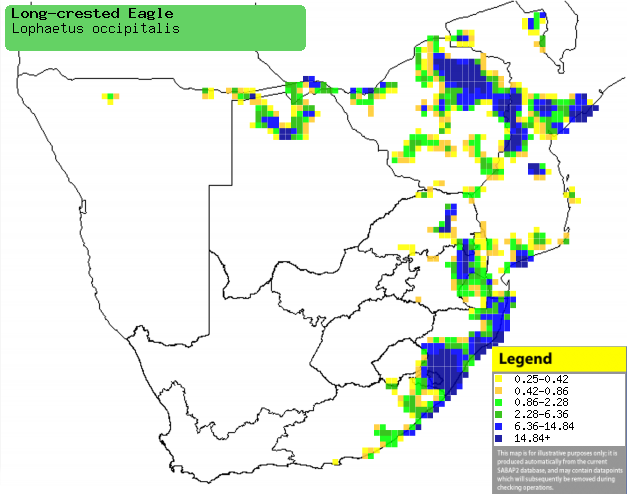|
Lophaetus occipitalis
(Long-crested eagle)
Langkuifarend [Afrikaans]; Isiphungu-phungu, Uphungu-phungu
[Xhosa]; isiPhungumangathi [Zulu]; Kondokondo, Pfinye [Shona];
Masworhimasworhi [Tsonga]; Afrikaanse zwarte kuifarend [Dutch]; Aigle
huppard [French]; Schopfadler [German]; Įguia-de-penacho [Portuguese]
Life
> Eukaryotes >
Opisthokonta
> Metazoa (animals) >
Bilateria >
Deuterostomia > Chordata >
Craniata > Vertebrata (vertebrates) > Gnathostomata (jawed
vertebrates) > Teleostomi (teleost fish) > Osteichthyes (bony fish) > Class:
Sarcopterygii (lobe-finned
fish) > Stegocephalia (terrestrial
vertebrates) > Tetrapoda
(four-legged vertebrates) > Reptiliomorpha > Amniota >
Reptilia (reptiles) >
Romeriida > Diapsida > Archosauromorpha > Archosauria >
Dinosauria
(dinosaurs) > Saurischia > Theropoda (bipedal predatory dinosaurs) >
Coelurosauria > Maniraptora > Aves
(birds) > Order: Falconiformes
> Family: Accipitridae
For information about this species, see
www.birdforum.net/opus/Long-crested_Eagle
Distribution and habitat
Occurs across sub-Saharan Africa; in southern Africa, it is locally common in Zimbabwe,
central and southern Mozambique, eastern South Africa, northern Botswana and the Caprivi Strip (Namibia). It generally prefers forest edges and moist woodland,
especially if it is adjacent to grassland, marsh or a watercourse; it may also occupy dry
woodland, mixed farmland, pastures, edges of sugar-cane plantations and
orchards.
|
 |
|
Distribution of Long-crested eagle in southern Africa,
based on statistical smoothing of the records from first SA Bird Atlas
Project (©
Animal Demography unit, University of
Cape Town; smoothing by Birgit Erni and Francesca Little). Colours range
from dark blue (most common) through to yellow (least common).
See here for the latest distribution
from the SABAP2. |
Predators and parasites
Nestlings are prey of monkeys (Cercopithecus),
while its eggs are eaten by genets (Genetta).
Movements and migrations
Mainly sedentary, although it may make local
movements.
Food
It mainly eats rodents, doing most of its hunting in the
early morning and late afternoon over a fairly small area. It usually hunts from
a perch from which it searches for prey; once it spots something it glides to
the ground and attempts to catch the animal. The following food items have been recorded
in its diet:
- Animals
- mammals
- birds
- frogs
- reptiles
- hatchery trout
- invertebrates
- Fruit
- Ficus (wild figs)
- Morus (mulberries)
Breeding
- Monogamous, territorial solitary nester, performing a courtship display in
which it dives steeply or flies level while rocking from side to side.
- The nest is built by both sexes, consisting of a stick platform with a
central
cup, lined with green leaves. It is typically
placed against the trunk of a tree in the mid-canopy, especially an Acacia,
fig (Ficus), Eucalyptus, Musasa (Brachystegia
spiciformis), willow (Salix) or Pecan nut tree (Carya
pecan). It may also use the nest of another bird, such as the
Black sparrowhawk or
Lizard buzzard.
- Egg-laying season is year-round, peaking from July-November.
- It lays 1-2 eggs, which are mainly incubated by the female for about 42
days, while the male provides her with food at the nest.
- The chicks hatch asynchronously, sometimes up to 15 days apart, and are
mainly fed by the male at first. They fledge at about 53 days old, remaining
dependent on their parents for roughly another 2-3 months.
Threats
Not threatened.
References
-
Hockey PAR, Dean WRJ and Ryan PG 2005. Roberts
- Birds of southern Africa, VIIth ed. The Trustees of the John Voelcker
Bird Book Fund, Cape Town.
|
